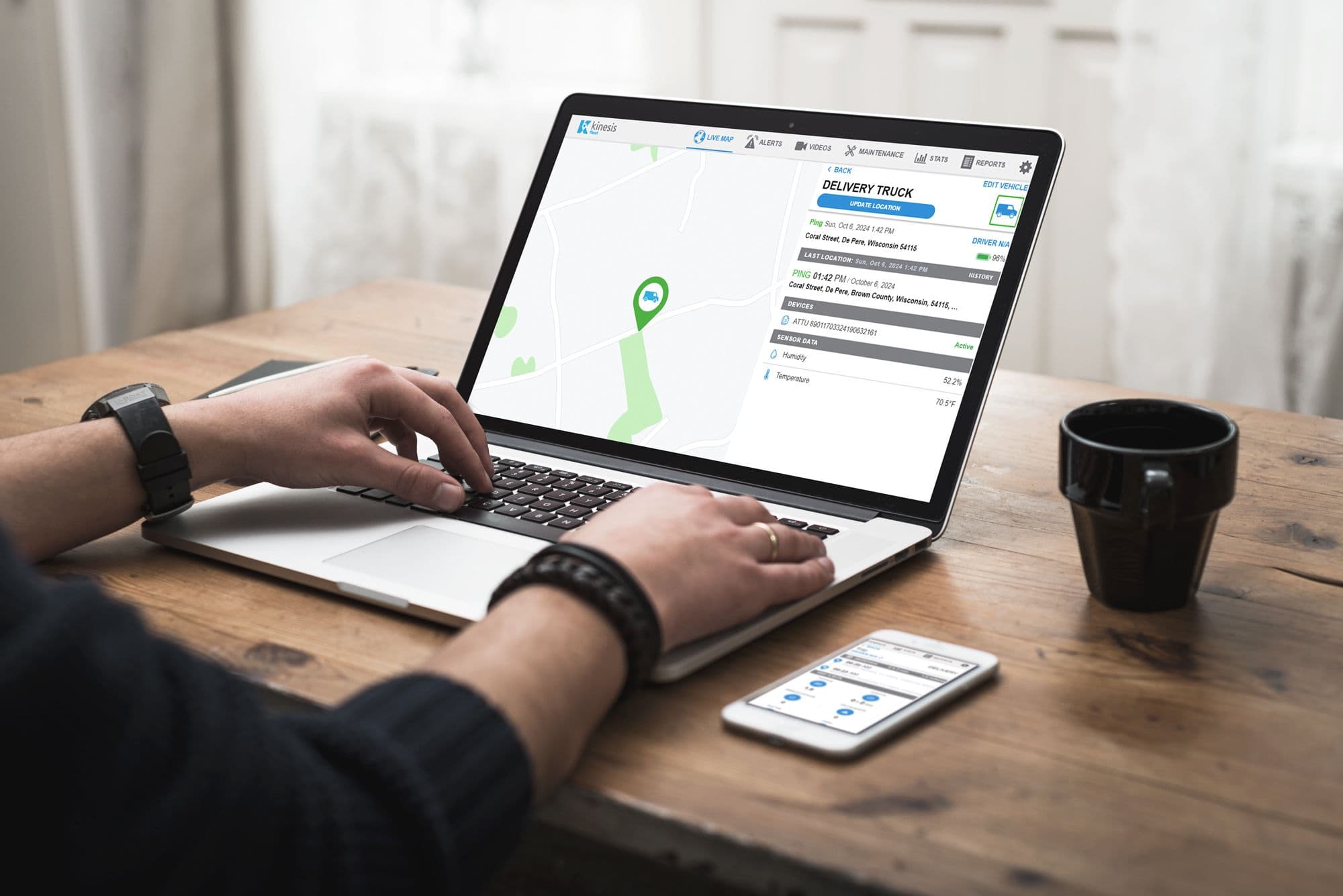Bluetooth vs. cellular trackers for asset tracking
Tracking high-value items like vehicles, tools or equipment helps improve visibility and reduce theft. Bluetooth and cellular technologies support today’s leading asset management solutions. Knowing how each works lets you choose the right tool for your business, whether you need indoor coverage or long-range performance.
What are asset trackers?
Asset trackers are small devices attached to equipment or inventory. They send exact location data to an asset management system.
Popular technologies include:
- Bluetooth tracking devices
- Cellular GPS trackers
- GPS tracking systems
- RFID tags
- Barcode labels
These technologies enable real-time monitoring and efficient communication between devices, enhancing the tracking of assets in various environments.
At Radius, we specialize in cellular tracking solutions that help businesses monitor assets in real time — even in the most remote or mobile environments. Our technology is a reliable choice for teams that need accurate location data without relying on nearby devices.
What is asset tracking?
Cellular trackers for outdoor and remote monitoring
How cellular tracking technologies work
Cellular trackers use mobile phone networks to send real-time location updates. A strong cellular network ensures stable tracking in remote or mobile environments.
Built-in cellular connectivity lets these trackers work without nearby devices, making them ideal for assets on the move.
Benefits of real-time tracking with cellular devices
A cellular GPS tracker helps monitor assets across extensive areas. It’s a smart choice for long-distance tracking in remote or complex locations.
This is especially useful for:
- Monitoring vehicles
- Keeping track of equipment at remote sites
- Protecting valuable shipments
Why use cellular trackers for long-distance asset visibility
- Wide-range coverage (nationwide and global)
- Real-time asset location tracking
- Geofencing and movement alerts
- Ideal for fleet management and outdoor assets
These features make cellular trackers effective for tracking valuable assets over large distances and in demanding environments.
GPS Asset tracking

Bluetooth tracking device for indoor asset monitoring
How Bluetooth tracking works
Bluetooth trackers use Bluetooth Low Energy (BLE) signals. They connect to smartphones or gateways within about 100 to 300 feet, making them ideal for indoor asset tracking.
Advantages of Bluetooth for indoor environments
Bluetooth tracking systems work well in offices, warehouses and healthcare settings. They connect well indoors, help find personal items or valuable equipment and send alerts when something moves out of range. These features make it easier for businesses to monitor assets and reduce the risk of loss or theft.
Bluetooth doesn’t offer full real-time tracking like cellular options, but it still meets indoor needs without draining the battery. These low-power technologies deliver “higher energy efficiency, extended coverage and lower connectivity cost,” making them ideal for affordable indoor IoT setups. (McKinsey)
Why Bluetooth Trackers are a smart choice for asset management
- Low cost
- Long battery life
- Easy setup
- Great for indoor environments
Bluetooth trackers support indoor monitoring of assets with less power, longer battery life and strong IoT compatibility. (McKinsey)
Bluetooth vs. cellular trackers: Key differences
| Feature | Bluetooth tracking devices | Cellular GPS trackers |
| Range and coverage | About 300 feet, best indoors; suitable for limited range tracking | Wide coverage, uses mobile networks |
| Battery life | Lasts months or years | Shorter, needs more charging |
| Cost | Lower hardware and maintenance costs | Higher costs due to hardware and data fees |
| Real time location system | Limited, depends on proximity | Continuous real-time updates everywhere |
| Best use case | Indoor assets like inventory and equipment | Vehicles, remote equipment, moving assets |
Testing asset tracking devices for accuracy and reliability
Before choosing a tracker, test it to ensure it works well. Here’s what to check:
- Location accuracy: Is it precise indoor and outdoor environments?
- Battery performance: How long does it last in real use?
- Signal reliability: Does it stay connected without drop-offs?
- Ease of setup: Is installation simple?
Testing helps ensure the device meets your needs today, but thinking long-term is just as important.
Lifecycle planning helps minimize long-term costs while improving the condition and performance of your assets. Choosing the right technology means balancing upfront investment with long-term value. (U.S. Department of Transportation)
How accurate are Bluetooth and cellular trackers?
It’s essential to understand how accurate each tracking option is before making a choice.
- Bluetooth tracking
Bluetooth works best in short-range areas like buildings or small warehouses. Depending on the space, it can track items within about 100 meters. According to Gauge Corp, walls and other signals can weaken the connection, affecting accuracy.
- Cellular GPS tracking
Cellular GPS trackers are better for long distances. They can give accurate locations when assets move between cities or across the country. However, Digital Matter notes that GPS signals can struggle indoors, especially in areas with thick walls or metal structures.

Real-world uses for Bluetooth and cellular trackers
Bluetooth tracker use cases
- Warehouse inventory management
- Office equipment tracking
- Healthcare asset tracking
- Preventing lost items
These applications demonstrate the versatility of Bluetooth-based asset tracking in various indoor asset tracking scenarios.
Cellular tracker use cases
- Fleet management and logistics
- Tracking high-value shipments
- Remote construction equipment monitoring
Cellular trackers are ideal for outdoor tracking and monitoring assets in harsh environments.
New tracking technologies are “transforming package visibility.” This allows logistics providers to monitor shipments more precisely than traditional barcode scans. (The Wall Street Journal)
Privacy and security concerns with trackers
Trackers send sensitive location data. Keeping this data safe is key.
Here’s how to protect your data:
- Use encryption to secure data transmission
- Manage assets with trusted, secure platforms
- Regularly update software and firmware
These asset tracking devices must be used responsibly, especially when real-time location data is involved. Implementing these measures helps prevent unauthorized access and ensures reliable communication between devices.
Asset tracking devices
What to consider when choosing asset tracking technology
Coverage needs
- Indoor assets → Bluetooth trackers work well
- Mobile or remote assets → Cellular trackers offer better coverage
Battery life
Bluetooth trackers last longer and need fewer battery changes. Cellular trackers provide real-time updates but use more power.
Cost-effectiveness
Bluetooth tracking devices have lower upfront costs. Cellular GPS trackers cost more but offer real-time location systems and a broader reach.
Choosing the best asset tracking device
Not every tracking device works the same. Keep these points in mind:
- Battery: Some trackers use replaceable batteries. Others offer extended battery life with less maintenance.
- Use case: For indoor or short-range tracking, choose BLE or active RFID. A cellular GPS tracker works best outdoors or for moving equipment.
- Range: Bluetooth works best in buildings. For long distances, GPS offers a more precise location.
- Budget: You may not need every advanced feature. Pick a cost-effective solution that fits your needs.
The right device saves time, avoids errors and improves visibility across different types of assets.
Device compatibility and system integration for trackers
Always check if your trackers work with your current systems.
Radius trackers integrate easily with:
- Fleet management platforms
- Inventory systems
- IoT dashboards
- Supply chain visibility software
Good integration saves time and helps your business run smoothly.
Integration with asset management software
Radius’ solutions connect seamlessly with:
- Fleet management systems
- Supply chain visibility solutions
This gives teams instant access to data from multiple systems in one place. It also helps reduce deployment costs and makes tracking different types of assets easier. Teams can make better decisions, even in standard or harsh environmental conditions.
Supply chain visibility and IoT asset management benefits
Tracking helps:
- Prevent theft
- Improve delivery speed
- Maintain inventory accuracy
- Facilitate smarter business decisions

Future outlook and innovations in trackers
The global smart tracker market is growing fast. By 2031, MetaStat projects the market will reach $5.6 billion. Technologies like Bluetooth, GPS and RFID drive this growth (Metastat).
Trends to watch include:
- 5G networks for faster real time location tracking
- Energy-harvesting trackers with no batteries
- AI and analytics to predict asset needs
- Hybrid devices combining Bluetooth, GPS and cellular tracking
GPS asset tracking from Radius
At Radius, we help businesses track assets using GPS solutions that combine reliable hardware and easy-to-use software.
Frequently asked questions
Can’t find an answer to your question? Talk to the Radius customer support team at 888-278-9781. We’re here to help with any questions or concerns.